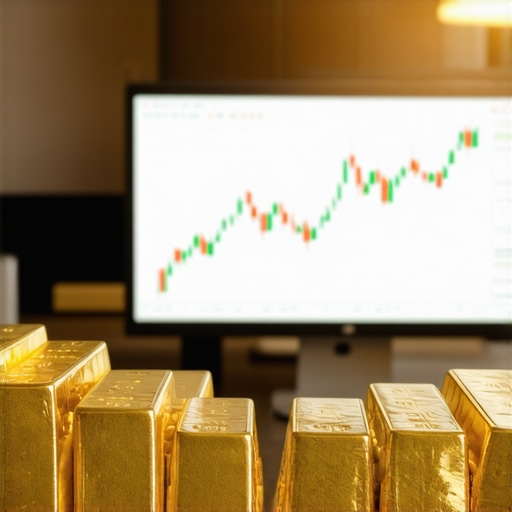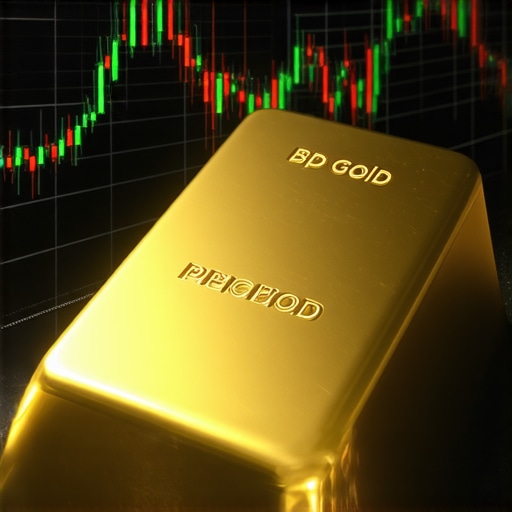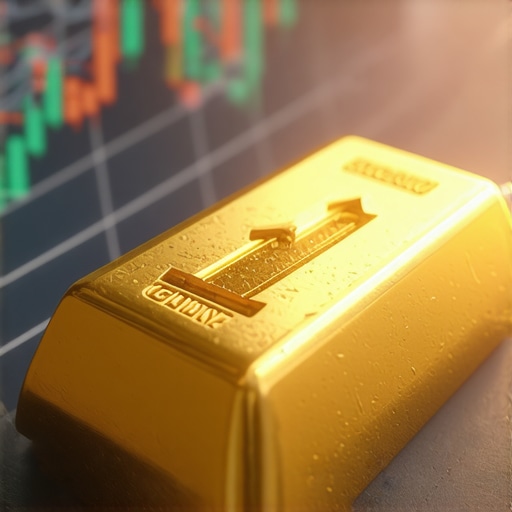Unlocking the Golden Horizon: Why Long-Term Gold Price Forecasts Matter
For seasoned investors and newcomers alike, understanding the long-term trajectory of gold prices is pivotal in crafting a resilient portfolio. Gold’s allure transcends mere aesthetics; it embodies a unique blend of economic insurance, inflation hedge, and a store of value that has endured through centuries. However, predicting its price movements over extended periods requires a nuanced grasp of multifaceted market forces, geopolitical dynamics, and evolving demand patterns.
Decoding the Dynamics: Key Drivers Behind Gold’s Long-Term Price Movement
Unlike volatile equities, gold’s price is influenced by a complex interplay of factors. Central bank policies, particularly quantitative easing and interest rate adjustments, sway investor confidence and currency valuations, which in turn affect gold demand. Additionally, global economic uncertainty, ranging from inflationary pressures to geopolitical tensions, often catalyzes gold’s appeal as a safe haven. Understanding these catalysts helps investors anticipate potential price trends rather than merely reacting to short-term fluctuations.
How Do Central Bank Gold Purchases Influence Long-Term Price Trends?
Central banks globally have increasingly augmented their gold reserves as a strategic response to currency volatility and geopolitical instability. When large institutions acquire significant gold quantities, it constrains supply and signals market confidence in gold’s enduring value, often precipitating upward price pressures. For instance, countries like China and Russia have demonstrated aggressive gold accumulation policies, reshaping global demand landscapes. Investors monitoring these purchases can glean critical insights into future price trajectories and market sentiment. For a deeper dive into this topic, explore how central bank gold purchases shape market trends.
Long-Term Gold Price Forecasting: Embracing Complexity with Analytical Rigor
Forecasting gold prices over years demands integrating macroeconomic forecasts with supply-demand analytics, mining production trends, and technological developments affecting extraction costs. Investors benefit from evaluating emerging trends in global gold demand, particularly in Asia, where cultural affinity and wealth growth continue to fuel consumption. Moreover, the rise of gold-backed ETFs and mutual funds adds layers of liquidity and market dynamics that must be considered. Recognizing these variables enhances predictive accuracy beyond simplistic assumptions.
Strategic Implications: How Investors Can Leverage Forecasts for Portfolio Resilience
Incorporating long-term gold price forecasts enables investors to strategically allocate assets, balancing growth with protection. Gold’s inverse correlation with equities during economic downturns makes it a prudent hedge, but timing and instrument selection are crucial. Whether investing in physical gold, mining stocks, or ETFs, understanding forecast nuances aids in optimizing entry and exit points. For those keen on physical assets, insights on physical gold investment benefits over digital alternatives provide valuable guidance.
Join the Conversation: What Are Your Gold Investment Strategies in Light of Long-Term Forecasts?
We invite our readers to share their perspectives and experiences regarding gold investments and how long-term price forecasts influence their decisions. Engage with our community by commenting below or sharing this article to spread informed investment strategies.
Source: For authoritative insights on gold market dynamics, the World Gold Council offers comprehensive analysis and data at gold.org.
Exploring Supply Constraints: How Mining Trends Impact Gold’s Long-Term Price Stability
Beyond demand-side influences, the supply landscape plays an equally critical role in shaping gold prices over the long haul. Mining output, affected by geological discoveries, technological advancements, and operational costs, can either ease or exacerbate supply shortages. In recent years, declining ore grades and stricter environmental regulations have raised extraction costs, potentially limiting supply growth. This scarcity effect tends to bolster gold prices, especially when coupled with rising demand from emerging markets and institutional investors.
Moreover, geopolitical risks in major gold-producing countries can disrupt supply chains, adding another layer of volatility that investors should monitor closely. For a comprehensive understanding of these dynamics, see our detailed analysis on analyzing gold mining stocks and essential metrics.
Decoding Investor Sentiment: The Role of Gold ETFs and Market Liquidity in Price Trends
In the modern investment landscape, gold-backed ETFs have revolutionized accessibility but also introduced complex liquidity dynamics. These financial instruments allow investors to gain exposure to gold without physical ownership, increasing market fluidity and sometimes amplifying short-term price swings. While ETFs enhance market participation, they also reflect broader investor sentiment—tracking inflows and outflows can offer predictive clues about upcoming price momentum.
Understanding the interplay between physical gold demand and ETF activity is essential for sophisticated forecasting. Investors who combine these insights with macroeconomic indicators are better positioned to anticipate price corrections or rallies. To explore effective gold trading techniques and how ETFs influence market behavior, consider our guide on gold trading techniques and ETF strategies.
Can Emerging Technologies and ESG Considerations Reshape Gold Demand and Pricing?
As environmental, social, and governance (ESG) criteria grow in prominence, the gold industry faces transformative pressures. Innovations in sustainable mining and recycling could alter supply dynamics, while investor preference for ESG-compliant assets may shift demand patterns. How will these evolving factors integrate into long-term price forecasts? Staying abreast of these trends can offer investors a competitive edge in an increasingly conscientious market.
For instance, the rise of blockchain-based traceability in gold sourcing enhances transparency, potentially boosting demand among ethically-minded investors. Moreover, the integration of green technologies may reduce production costs over time, influencing supply curves. Analysts from the World Gold Council emphasize the importance of ESG in future market assessments (World Gold Council ESG insights).
Integrating Forecasts into Portfolio Design: Balancing Gold with Diversified Assets for Risk Mitigation
Long-term gold price forecasts are invaluable for constructing portfolios that withstand economic turbulence. Strategic allocation to gold should be calibrated with other assets such as equities, bonds, and alternative investments to optimize risk-adjusted returns. For example, during periods of inflationary pressure, gold’s positive correlation with real assets can offset declines in fixed income.
Investors can leverage forecasts to time entries into gold ETFs or mining stocks while maintaining liquidity for opportunistic trades. For guidance on building balanced portfolios with gold instruments, see our expert tips on how to build a balanced portfolio with gold stocks and ETFs.
We encourage readers to share their strategies and insights on incorporating gold forecasts into diversified investment plans. Join the conversation by commenting below or sharing this article with your network to foster a community of informed investors.
Harnessing Quantitative Models and Machine Learning for Enhanced Gold Price Predictions
Traditional forecasting methods, while valuable, often fall short in capturing the intricate nonlinear relationships governing gold prices over the long term. Enter the realm of quantitative analytics and machine learning (ML), which offer sophisticated tools to decipher complex patterns hidden within vast datasets. Techniques such as time-series analysis, neural networks, and ensemble learning models enable investors to integrate multifactorial influences—including macroeconomic indicators, geopolitical events, mining supply fluctuations, and even social media sentiment—into dynamic predictive frameworks.
For instance, recurrent neural networks (RNNs) and long short-term memory (LSTM) models excel at recognizing temporal dependencies, making them particularly adept at forecasting gold price trends based on historical data sequences. Moreover, incorporating alternative data sources, such as satellite imagery of mining activities or blockchain transaction flows of gold-backed assets, can provide real-time signals often neglected by conventional analyses.
While ML models require rigorous validation to prevent overfitting and ensure interpretability, their application heralds a paradigm shift in investment strategy development. Investors leveraging these advanced analytics gain a competitive edge by anticipating market inflection points with greater precision.
What Are the Challenges and Limitations of Using AI-Based Models in Gold Price Forecasting?
Despite their promise, AI-driven forecasting models face hurdles including data quality issues, model transparency, and the unpredictable nature of exogenous shocks such as geopolitical crises or unprecedented monetary policies. Furthermore, gold markets can be influenced by irrational investor behavior and sentiment-driven rallies that defy algorithmic prediction. Therefore, combining AI insights with expert judgment and fundamental analysis remains essential for robust decision-making.
For an in-depth exploration of AI applications in commodity markets, refer to the research by the National Bureau of Economic Research on Machine Learning in Financial Forecasting.
Global Macroeconomic Shifts: The Impact of Emerging Currency Paradigms on Gold Valuation
The evolving landscape of international finance, characterized by the emergence of digital currencies and shifting reserve currency dynamics, adds layers of complexity to gold’s valuation. Central bank digital currencies (CBDCs) and cryptocurrencies challenge traditional monetary frameworks, potentially altering gold’s role as a hedge against fiat currency depreciation. Moreover, the gradual de-dollarization trend among some economies influences gold demand and pricing mechanisms.
Investors must therefore scrutinize how these macroeconomic transformations interplay with gold markets. For example, persistent geopolitical frictions encouraging diversification away from the US dollar often catalyze gold accumulation, pushing prices upward. Conversely, widespread adoption of stable digital currencies backed by tangible assets could modulate gold’s safe-haven appeal.
Strategic Innovations: Integrating Sustainable Practices and Blockchain for Transparent Gold Investment
As ESG considerations reshape investment paradigms, blockchain technology emerges as a powerful enabler for transparency and traceability in the gold supply chain. By certifying provenance and ensuring ethical sourcing, blockchain solutions enhance investor confidence, potentially stimulating demand for responsibly mined gold. This intersection of technology and sustainability not only mitigates reputational risks but also aligns with the growing preference of institutional investors for ESG-compliant assets.
Furthermore, innovations in recycling technologies and urban mining contribute to a circular gold economy, easing supply constraints and influencing long-term price stability. Stakeholders who monitor these advancements can better anticipate shifts in supply-demand equilibria.
Ready to deepen your expertise on integrating advanced analytics and sustainable innovations into your gold investment strategy? Explore our comprehensive resources and join our expert-led webinars to stay ahead in this evolving market.
Leveraging Artificial Intelligence: Revolutionizing Gold Price Forecasting Methodologies
In the pursuit of heightened predictive accuracy, the integration of artificial intelligence (AI) and machine learning (ML) techniques has transformed traditional gold price forecasting. By assimilating vast heterogeneous datasets—ranging from macroeconomic indicators, geopolitical event timelines, mining production statistics, to social media sentiment analysis—AI models uncover latent, nonlinear relationships that elude conventional econometric approaches. These innovations empower investors to anticipate market inflection points with greater temporal precision, enhancing strategic decision-making in a notoriously complex asset class.
Moreover, advanced algorithms such as Long Short-Term Memory (LSTM) networks and ensemble learning facilitate dynamic adaptation to evolving market regimes, accommodating sudden shocks and structural breaks. This computational sophistication, however, necessitates rigorous model validation and interpretability frameworks to mitigate risks of overfitting and ensure actionable insights.
How Can Investors Mitigate Risks When Employing AI-Driven Models for Gold Price Forecasting?
While AI-powered models offer substantial promise, investors must recognize inherent limitations including data quality discrepancies, model opacity, and susceptibility to unforeseen exogenous shocks. A judicious approach involves complementing algorithmic outputs with domain expertise and fundamental analysis to contextualize predictions. Continuous model recalibration and transparency in feature importance further enhance robustness. For a comprehensive examination of these challenges and best practices, the National Bureau of Economic Research’s study on Machine Learning in Financial Forecasting provides authoritative guidance.
Decoding the ESG Revolution: Sustainable Innovations Reshaping Gold’s Market Dynamics
The ascendancy of Environmental, Social, and Governance (ESG) frameworks is catalyzing profound transformation within the gold industry, compelling stakeholders to adopt sustainable mining practices and transparent supply chains. Innovations such as blockchain-enabled provenance verification enhance traceability, bolstering investor confidence and aligning gold assets with ethical investment mandates. Concurrently, advancements in recycling technologies and urban mining are fostering a circular economy paradigm, mitigating supply constraints and potentially stabilizing price volatility over the long term.
Institutional investors increasingly prioritize ESG-compliant gold products, thereby influencing demand patterns and encouraging mining companies to integrate rigorous sustainability metrics. This confluence of technology and responsible investment not only mitigates reputational risk but also unlocks novel market segments, ultimately redefining gold’s valuation framework.
Currency Paradigm Shifts: Navigating Gold’s Role Amidst Digital and Geopolitical Transformations
The global monetary architecture is undergoing seismic shifts with the proliferation of Central Bank Digital Currencies (CBDCs), cryptocurrencies, and the gradual de-dollarization movement. These forces intricately influence gold’s traditional role as a hedge against fiat currency depreciation. For instance, as certain economies diversify reserves away from the US dollar due to geopolitical tensions, gold accumulation surges, exerting upward pressure on prices. Conversely, the emergence of asset-backed stablecoins and CBDCs introduces alternative store-of-value mechanisms that may recalibrate gold’s safe-haven appeal.
Investors must vigilantly monitor these macroeconomic and technological evolutions to adeptly position gold within diversified portfolios, recognizing that gold’s valuation is increasingly entwined with the trajectory of digital currencies and shifting reserve currency hegemonies.
Engage with the Future: Harness Cutting-Edge Insights to Elevate Your Gold Investment Strategy
We invite sophisticated investors and market analysts to delve deeper into these advanced dimensions shaping gold’s long-term prospects. Explore our curated resources and participate in upcoming expert webinars to master AI-driven forecasting, ESG integration, and geopolitical currency dynamics. Embrace these insights to fortify your portfolio resilience and capitalize on emergent opportunities in the evolving gold market landscape.
Frequently Asked Questions (FAQ)
What factors most significantly influence gold prices over the long term?
Long-term gold prices are shaped by a multifaceted set of drivers including central bank policies, global macroeconomic conditions, geopolitical tensions, mining supply constraints, technological innovations, and shifting investor sentiment. Additionally, emerging forces like ESG considerations and the evolving digital currency landscape increasingly impact demand and valuation.
How do central bank gold purchases affect gold’s price trajectory?
Central bank acquisitions reduce market supply while signaling confidence in gold’s value as a reserve asset. Large-scale purchases by countries such as China and Russia often precipitate upward price momentum by tightening availability and encouraging private investor demand.
Can machine learning and AI models reliably forecast long-term gold prices?
AI and machine learning models enhance forecasting accuracy by uncovering complex nonlinear patterns and integrating diverse datasets, including macroeconomic indicators and sentiment analysis. However, they require rigorous validation and should be complemented with expert judgment due to challenges like data quality issues and unpredictable exogenous shocks.
How are ESG trends reshaping the gold market and price outlook?
Environmental, social, and governance factors are transforming gold mining and investment paradigms through sustainable extraction practices, blockchain-enabled provenance verification, and increased demand for ethically sourced gold. These innovations influence supply stability and attract ESG-conscious investors, potentially supporting more resilient long-term prices.
What impact do digital currencies and de-dollarization have on gold’s role as a safe haven?
The rise of central bank digital currencies and cryptocurrencies introduces alternative store-of-value mechanisms that could recalibrate gold’s traditional hedge role. Simultaneously, geopolitical-driven de-dollarization encourages gold accumulation as a diversification tool, often exerting upward price pressure.
How should investors incorporate long-term gold price forecasts into their portfolios?
Informed allocation to gold—whether via physical assets, ETFs, or mining stocks—should balance risk mitigation with growth objectives. Using long-term forecasts enables timing of entry and exit points and calibration alongside other asset classes to optimize portfolio resilience amid inflation and market volatility.
What are the main challenges when relying solely on quantitative models for gold price predictions?
Quantitative models can suffer from overfitting, lack transparency, and may not fully capture irrational market behaviors or sudden geopolitical events. Integrating these models with fundamental analysis and continuous recalibration is essential to maintain robustness.
How do mining supply trends and technological advancements influence gold prices?
Declining ore grades, environmental regulations, and geopolitical risks constrain supply, supporting higher prices. Conversely, advances in sustainable mining and recycling technologies may alleviate supply pressures. Monitoring these trends is critical to understanding price dynamics.
What role do gold-backed ETFs play in shaping market liquidity and price movements?
Gold ETFs increase market accessibility and liquidity but can amplify price volatility due to rapid inflows and outflows reflecting investor sentiment. Tracking ETF activity alongside physical demand provides nuanced insight into price momentum.
How can investors stay ahead in the evolving gold market landscape?
By leveraging advanced analytics such as AI-driven forecasting, embracing ESG insights, monitoring macroeconomic shifts including digital currency developments, and engaging with expert-led resources, investors can enhance decision-making and capitalize on emerging opportunities.
Trusted External Sources
- World Gold Council (gold.org): The foremost authority on gold market data, trends, and ESG initiatives, providing comprehensive analysis vital for understanding global gold dynamics and investor behavior.
- National Bureau of Economic Research (NBER) (Machine Learning in Financial Forecasting): Offers in-depth research on AI and machine learning applications in financial markets, including critical evaluations of model limitations and best practices relevant to gold price prediction.
- International Monetary Fund (IMF): Provides macroeconomic data and analysis on currency paradigms, digital currencies, and reserve management impacting gold valuation within global financial systems.
- Bloomberg Intelligence: Delivers expert market insights, real-time data on gold ETFs, mining stocks, and geopolitical developments influencing gold prices and investor sentiment.
- Journal of Sustainable Mining: Publishes cutting-edge research on environmental and social innovations in mining that directly affect supply conditions and ESG compliance in the gold sector.
Conclusion
Understanding the long-term trajectory of gold prices demands an integrative approach that synthesizes macroeconomic fundamentals, supply-demand intricacies, technological advancements, and evolving market paradigms such as ESG and digital currencies. Central bank policies, mining trends, and investor sentiment interplay dynamically, shaping gold’s enduring role as a strategic asset and inflation hedge. The advent of AI and machine learning introduces powerful predictive tools, yet their efficacy hinges on expert oversight and contextual awareness. As the financial landscape transforms, investors who adeptly incorporate advanced analytics alongside sustainable innovations and geopolitical insights will position themselves to navigate gold market complexities with confidence.
Empower your investment strategy by engaging with our expert content, sharing your perspectives, and exploring our in-depth resources to stay at the forefront of gold market evolution.










